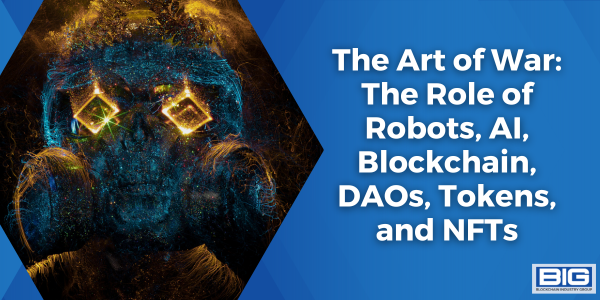
The landscape of warfare is undergoing a profound transformation with the integration of cutting-edge technologies.
In this article, we delve into the role of robots, artificial intelligence (AI), blockchain, decentralized autonomous organizations (DAOs), tokens, and non-fungible tokens (NFTs) in the modern art of war. We explore how these technologies are reshaping military strategies, revolutionizing defense systems, and introducing new dynamics in the realm of security.
Robots on the Battlefield: Automating Warfare
Robots are increasingly playing a critical role in modern warfare, automating tasks that were once performed by human soldiers. From unmanned aerial vehicles (UAVs) to ground-based robots, these machines offer advantages in surveillance, reconnaissance, logistics, and even combat.
Example: Predator Drone and Targeted Strikes
The Predator drone, armed with AI-powered targeting systems, revolutionized the concept of targeted strikes. These autonomous UAVs can gather real-time intelligence, track targets, and engage them with precision. This technology has transformed warfare, enabling remote operations, reducing risks to human personnel, and providing enhanced capabilities for surveillance and intelligence gathering.
AI-Powered Defense Systems: Enhancing Security
Artificial intelligence plays a pivotal role in enhancing defense systems and bolstering security measures. AI algorithms can analyze massive amounts of data, detect patterns, and make informed decisions in real-time, enabling rapid responses to threats and optimizing defensive strategies.
Example: AI-Powered Intrusion Detection Systems
AI-powered intrusion detection systems can identify potential cyber threats, detect anomalies in network traffic, and prevent unauthorized access to critical military systems. These systems employ machine learning algorithms to continuously learn and adapt to evolving security risks, ensuring proactive defense against cyber attacks.
Blockchain for Secure Communication and Supply Chain Management
Blockchain technology offers secure and transparent communication channels and improves supply chain management in the context of warfare. By leveraging blockchain’s decentralized and immutable nature, military forces can enhance the integrity and traceability of communications, as well as streamline logistical operations.
Example: Secure Communication and Information Sharing
Blockchain-based communication platforms can provide secure channels for military personnel to exchange sensitive information, ensuring confidentiality and preventing unauthorized tampering or interception. Blockchain’s transparency also facilitates secure and auditable information sharing between allied forces, enhancing coordination and collaboration in joint military operations.
DAOs and Tokenized Warfare: Decentralized Decision-Making
Decentralized autonomous organizations (DAOs) are emerging as a paradigm for decentralized decision-making in the context of warfare. DAOs allow military forces to make collective decisions, allocate resources, and execute strategies in a transparent and decentralized manner.
Example: Collaborative Defense Strategies
DAOs enable military forces to pool their resources, expertise, and intelligence, fostering collaborative defense strategies. Through decentralized governance structures, stakeholders can participate in decision-making processes, ensuring a broader range of perspectives and increasing the agility and adaptability of military operations.
NFTs for Military Assets and Identity
Non-fungible tokens (NFTs) have the potential to redefine ownership and authentication of military assets, as well as establish digital identity for personnel. NFTs provide unique digital representations of physical assets or digital artifacts, allowing for verifiable ownership and provenance.
Example: Tokenizing Military Equipment and Collectibles
AI Investment Services: Top 5 Ideas
—
AI Software Applications: Top 5 Ideas
—
AI-Created Videos: A Threat to YouTube?
By tokenizing military assets and collectibles, NFTs enable the secure transfer of ownership and the establishment of digital records of authenticity. Military equipment, such as tanks or aircraft, can be represented as NFTs, ensuring proper tracking, maintenance, and ownership verification. Furthermore, NFTs can be utilized to tokenize military memorabilia, allowing collectors to own digital representations of historical artifacts and participate in exclusive experiences related to military history.
Shaping the Future of Warfare
The integration of robots, AI, blockchain, DAOs, tokens, and NFTs is reshaping the landscape of warfare and security. These technologies offer new opportunities for automation, enhanced defense systems, secure communication, decentralized decision-making, and innovative ownership models. While they bring tremendous advantages, it is crucial to address ethical considerations, ensure accountability, and mitigate potential risks associated with their implementation in military contexts. As these technologies continue to advance, they will undoubtedly shape the future of warfare, introducing new dynamics, and transforming how nations strategize and protect their interests.



